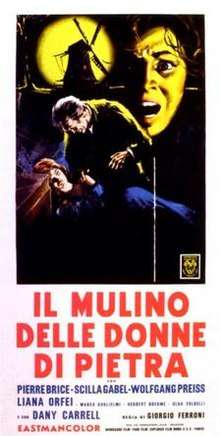Mill of the Stone Women
Mill of the Stone Women (Italian: Il mulino delle donne di pietra) is a 1960 italian-W.German-Spanish-French international co-production horror film directed by Giorgio Ferroni. The film stars Pierre Brice and Scilla Gabel.
| Mill of the Stone Women | |
|---|---|
 Italian film poster | |
| Directed by | Giorgio Ferroni |
| Screenplay by |
|
| Story by | Remigio Del Grosso[1] |
| Starring | |
| Music by | Carlo Innocenzi[1] |
| Cinematography | Pier Ludovico Pavoni |
| Edited by | Antonietta Zita [1] |
Production companies |
|
| Distributed by | C.D.C. (Italy)[1] |
Release date |
|
Running time | 100 minutes[1] |
| Country |
|
| Box office | ₤164 million |
Released on 30 August 1960 in Italy, the film became the first Italian horror film shot in color.
Plot
Writer Hans van Arnhim travels to a remote island in Holland to research a story about the fabled Mill of the Stone Women, a carousel of female statues created by art professor and sculptor Professor Gregorious Wahl. Hans meets and falls in love with Elfie, the professor's attractive but ailing daughter. Hans pieces together clues that Professor Wahl and Dr. Loren Bohlem are conducting experiments in a secret lab to cure Elfie's mysterious illness. All the while there are reports that local women are going missing.
Cast
- Pierre Brice as Hans von Arnim
- Scilla Gabel as Elfie Wahl
- Wolfgang Preiss as Dr. Loren Bohlem
- Dany Carrel as Liselotte Kornheim
- Herbert A.E. Böhme as Professor Gregorius Wahl
- Liana Orfei as Annelore
- Marco Guglielmi as Ralf
- Olga Solbelli as Selma
- Alberto Archetti as Konrad
Production
The opening credits of Mill of the Stone Women claim the film's plot is based on a short story by Pieter van Weigen in the book Flemish Tales.[2] This is fiction by the film's publicity department as there is no book by that title or Flemish author by that name.[2]
Shot by director of photography Pier Ludovico Pavoni, this was the first Italian horror film shot in color.[1][3]
Release
Mill of the Stone Women was released in Italy on 30 August 1960.[1] This made it the third locally based horror film released in Italy in August of that year after Black Sunday and Atom Age Vampire.[1][2]
The film grossed higher than both Black Sunday and Atom Age Vampire in Italy with a total of 164 million Italian lira.[1] Roberto Curti, author of Italian Gothic Horror films, 1957–1969, described this gross as disappointing in its home country but more successful abroad where it was distributed by Galatea.[2]
Reception
From contemporary reviews La Stampa, stated that Ferroni directed the film with skill and technique, but the film resorts to cliches of coffins, corpses and screams that make any scary moments less frequent than expected.[4] The Monthly Film Bulletin stated that the "flat countryside of Holland, with its windmills, provides some unusual, if rather neglected settings for this macabre, Grand Guignol piece", while the review concluded that "apart from the grandstand finish, which is unusually good within its melodramatic limits, the pace is dreadfully sluggish and monotonous."[5]
In his book Italian Horror Film Directors, Louis Paul praised the visual appearance of the film, inspired by Flemish and Dutch painters. And while critiquing the rhythm of the film, he noted its "memorable images".[6]
See also
- French films of 1960
- Italian films of 1960
- List of horror films of 1960
References
Notes
- Curti 2015, p. 49.
- Curti 2015, p. 50.
- Curti 2015, p. 52.
- "Giulietta Romeo e le tenebre un amore stroncato dal nazismo". La Stampa (in Italian). 9 March 1961. p. 4. Retrieved 26 August 2015.
Il regista Giorgio Ferroni ha diretto con perizia e con tecnica abbastanza curata, ma si e accontentato del consueto armamentario di bare, cadaveri, urli e scricchiolii per provocare i brividi. Cosi che questi, per la forza dell'abitudine, sono meno frequenti del previsto.
- "Mulino delle donne di pietra, Il (Drops of Blood), Italy/France 1960". Monthly Film Bulletin. Vol. 30 no. 348. British Film Institute. 1963. p. 102.
- Paul 2005, p. 16.
Bibliography
- Curti, Roberto (2015). Italian Gothic Horror Films, 1957-1969. McFarland. ISBN 1476619891.CS1 maint: ref=harv (link)
- Paul, Louis (2005). Italian Horror Film Directors. McFarland. ISBN 978-0-7864-8749-3.CS1 maint: ref=harv (link)
- Hughes, Howard (2011). Cinema Italiano - The Complete Guide From Classics To Cult. London - New York: I.B.Tauris. ISBN 978-1-84885-608-0.